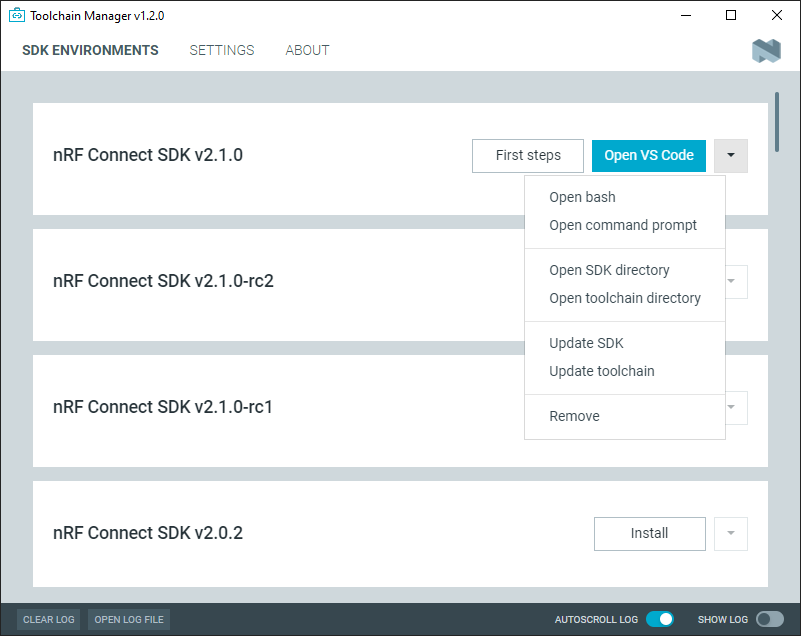Building and programming an application
For simplicity, this guide will refer to both samples and applications as “applications”.
For additional information, check the user guide for the hardware platform that you are using. These user guides contain platform-specific instructions for building and programming. For example, see Building and programming a sample in the Developing with nRF5340 DK user guide for information about programming an nRF5340 DK, or Programming precompiled firmware images and Building and programming from the source code for information about programming a Thingy:91.
Note
On Windows, because of the Windows path length limitations, the build can fail with errors related to permissions or missing files if some paths in the build are too long.
To avoid this issue, shorten the build folder name, for example, from build_nrf5340dk_nrf5340_cpuapp_ns to build, or shorten the path to the build folder in some other way.
Building with Visual Studio Code
For instructions about building with the nRF Connect for VS Code extension, see How to build an application. If you want to build and program with custom options, read about the advanced Custom launch and debug configurations.
For information about how to flash and erase in the nRF Connect for VS Code extension, read about the Application-specific flash options.
Note
Some samples in the nRF Connect SDK are currently not designed to work out-of-tree. You may need to manually configure your sample to work correctly in the nRF Connect for VS Code extension.
For more information about files generated as output of the build process, see Output build files.
Building on the command line
After completing the manual or automatic command-line build setup, use the following steps to build nRF Connect SDK projects on the command line.
Open a terminal window.
If you have installed the nRF Connect SDK using the Toolchain Manager, click the down arrow next to the version you installed and select Open bash.

The Toolchain Manager dropdown menu options
Go to the specific application directory.
For example, if you want to build the Cellular: AT Client sample, run the following command to navigate to its directory:
cd nrf/samples/cellular/at_clientBuild the application using the west command. The build target is specified by the parameter build_target in the west command as follows:
west build -b build_target
See Board names for more information on the supported boards and build targets. The board targets supported for a given application are always listed in its requirements section.
After running the
west buildcommand, the build files can be found inbuild/zephyr. For more information about files generated as output of the build process, see Output build files. For more information on the contents of the build directory, see Build Directory Contents in the Zephyr documentation.Important
If you are working with an nRF9160 DK, make sure to select the correct controller before you program the application to your development kit.
Set the SW10 switch (marked debug/prog) in the NRF91 position to program the main controller, or in the NRF52 position to program the board controller. In nRF9160 DK v0.9.0 and earlier, the switch is called SW5. See the Device programming section in the nRF9160 DK User Guide for more information.
Connect the development kit to your PC using a USB cable.
Note
To program the nRF52840 Dongle instead of a development kit, skip the following instructions and follow the programming instructions in nRF52840 Dongle.
Power on the development kit.
Program the application to the kit using the following command:
west flash --eraseThis command erases the full flash memory before programming, which is the recommended approach. If the application depends on other flash memory areas (for example, if it uses the Settings partition where bonding information is stored), erasing the full kit before programming ensures that these areas are updated with the new content.
As an alternative, you can also clear only those flash memory pages that are to be overwritten with the new application. With such approach, the old data in other areas will be retained.
To erase only the areas of flash memory that are required for programming the new application, use the following command:
west flashThe
west flashcommand automatically resets the kit and starts the application.
For more information on building and programming using the command line, see the Zephyr documentation on Building, Flashing and Debugging.
Optional build parameters
You can customize the basic west build command in a variety of ways.
Here are some of the possible options you can use:
Some applications contain configuration overlay files that enable specific features. These can be added to the
west buildcommand as follows:west build -b build_target -- -DOVERLAY_CONFIG="overlay-feature1.conf;overlay-feature2.conf"
See Permanent changes and Zephyr’s One-Time CMake Arguments for more information.
You can include the directory_name parameter to build from a directory other than the application directory.
You can use the build_target@board_revision parameter to get extra devicetree overlays with new features available for a board version. The board_revision is printed on the label of your DK, just below the PCA number. For example, if you run the west build command with an additional parameter
@1.0.0for nRF9160 build target, it adds the external flash on the nRF9160 DK that was available since board version 0.14.0.You can start menuconfig with the west command to configure your application.
You can reuse an existing build directory for building another application for another board or build target by passing
-p=autotowest build.
For more information on other optional build parameters, run the west build -h help text command.
